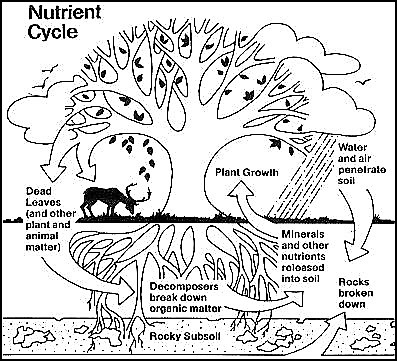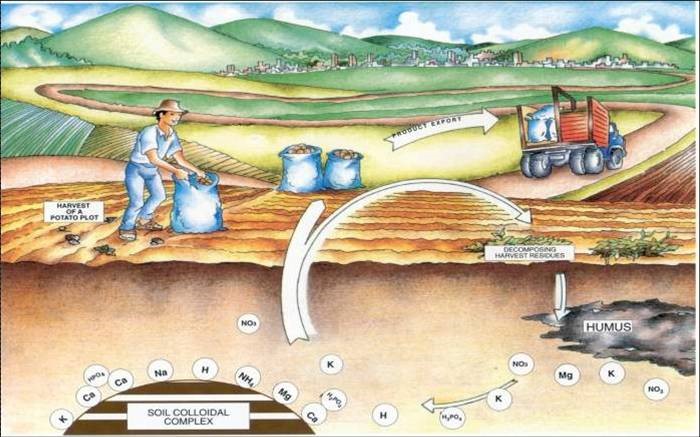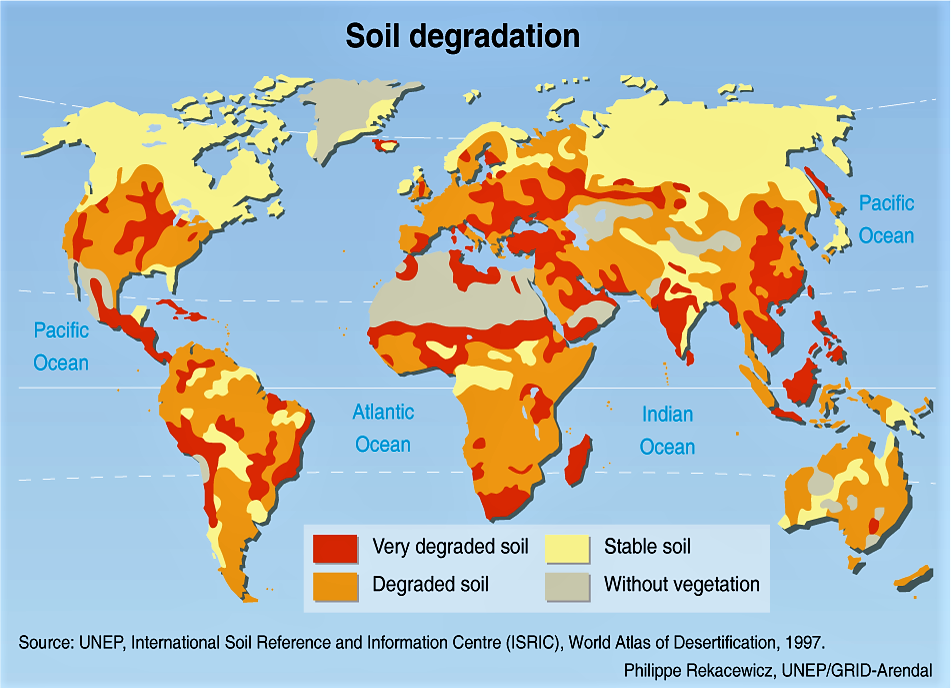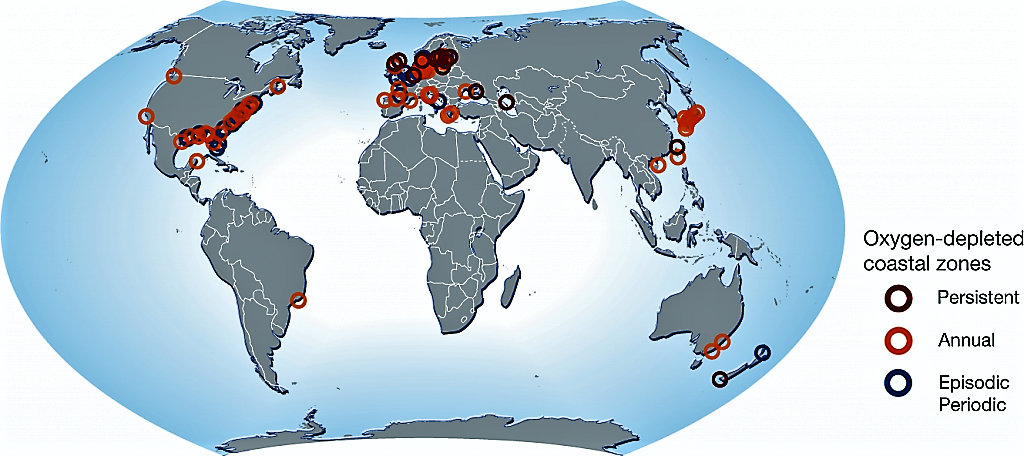المُلخص التنفيذي
The nutrient cycle describes how nutrients move from the physical environment into living organisms, and subsequently are recycled back to the physical environment. This movement of nutrients, essential for life, from the environment into plants and animals and back again, is a vital function of the ecology of any region. In any particular environment, the nutrient cycle must be balanced and stable if the organisms that live in that environment are to flourish and be maintained in a constant population (MARTIN 2010). Currently, large parts of humankind influence the nutrient cycle in such a way that we remove nutrients from the land and discharge them into aquatic environments. On the one hand, this leads to soil depletion on the land, and on the other hand, an overabundance of nutrients and pollution of water sources.
Nutrients — the fuel of life
Nutrients are chemical elements that all plants and animals require for growth. On the earth, there is a constant and natural cycle how these elements are incorporated when an organism grows, and degraded if an organism dies. The nutrients used in the largest amounts are the non-mineral elements, i.e. carbon (C), hydrogen (H) and oxygen (O). These elements are mainly taken up as carbon dioxide (CO2) from the air, and water (H2O) by the roots (JOENSSON et al. 2004). They make up 95-98% of the mass of all living beings (MAHENDRAPPA 2007). But they are, however, not sufficient for life to exist.
Further elements are important to fuel life on earth: Nitrogen (N) and Phosphorus (P), Potassium (K) as well as Calcium (Ca) and Magnesium (Mg) are highly important, in particular for plant growth and agriculture. These elements are often referred to as macro nutrients. Their uptake is about 100 times that of micro nutrients. Further nutrients, that plants take up in a much smaller amount and that are essentially consumed by humans, include Boron (Bh), Copper (Cu), Iron (Fe), Chloride (Cl), Manganese (Mn), Molybdenum (Mo) and Zinc (Zn) and others. These are called micro nutrients (JOENSSON et al. 2004).
Natural nutrient cycles

These nutrients – essentially chemical elements – are continuously in a circular movement, the nutrient cycle. The nutrient cycle is hence a general term that describes how nutrients move from the physical environment into living organisms, and are subsequently recycled back to the physical environment (MARTIN 2010). Nutrients in the soil are taken up by plants, which are consumed by humans or animals, and excreted again by them — or they are released back into the environment when organisms die (e.g. plants lose their leaves). Microorganisms in the soil break this matter down, and again make nutrients available in their mineral form, which makes it possible for plants to take them up again (see also nutrient requirements of plants).
Essentially, all nutrients that plants and also human beings require to survive are cycled in this way. In relation to water management and sanitation, it is mainly N, P and K that are of high priority. They are the most important nutrients to sustain plant growth and agriculture, and thus humanity.
How humans influence nutrient cycles

As described above, nutrients are continuously recycled in a natural ecosystem. In recent decades, population growth and resulting human activities such as large-scale farming have caused some significant changes in nutrient cycles.
With harvesting crops, nutrients are removed from the soil. For centuries, dung from animals has been used as a fertiliser to restore the nutrients back to the soil, and in many cultures – e.g. in Europe, or also in China, also human excreta have been recycled back to agricultural fields. Hence, nutrients went back into the soil at roughly the rate they had been withdrawn. However, with the introduction of water-borne sewage, this cycle was interrupted and replaced by a linear system that transports nutrients away from soils and into watercourses (see also water pollution).
Furthermore, agriculture also influences the nutrient cycle in another way: agriculture accelerates land erosion — because ploughing and tilling disturb and expose the soil — so more nutrients drains away with runoff (see also soil degradation). And flood control contributes to disrupting the natural nutrient cycle. Typically river floods would redistribute nutrient-rich sediments to lower lands where it is again available for ecosystems. Instead dams trap sediment or embankments confine it to the river until it washes out to sea. So too much nutrients from eroded soil and from human and animal waste ends up in lakes and oceans, where it spurs massive, uncontrolled blooms of algae. Once they die and fall to the bottom, their decay starves other organisms of oxygen, creating “dead zones” and contributing to the depletion of fisheries (VACCARI 2009).

Essentially, the human alterations to the nutrient cycle leads to an excess of nutrients in aquatic ecosystems and a serious lack of nutrients in agriculture. Worldwide, more and more soils are deplete of nutrients, with serious consequences to agricultural production and food security.
The lack of nutrients in agriculture is often made up by applying artificial fertilisers. However there are several problems related to this strategy:
- Artificial fertilisers usually contain only the most important macro nutrients nitrogen, phosphorus and potassium and lack other essential trace elements. This eventually leads to a soil deplete in micro nutrients.
- Phosphorus is a finite resource. "China, Morocco and the United States alone currently produce almost two thirds of global phosphate. Estimates on the remaining amount of phosphorus vary, as do projections about how long it will take to deplete the irreplaceable resource entirely. Figures for easily exploitable reserves range from 60-130 years (TIESSEN 1995; STEEN 1998), but all sources agree that continued phosphorus production will decline in quality and increase in cost. It imperative that we begin recycling phosphorus and returning it to the soil to decrease the need for mined phosphorus as artificial fertiliser. Within a half century, the severity of this crisis will result in increasing food prices, food shortages and geopolitical rifts."
- Nitrogen, on the other hand, is available abundantly. 78% of the air is composed of nitrogen. However, the process of producing nitrogen is highly energy consuming and relies mostly on fossil fuels – which, on the other hand, are finite.
- The element potassium is available abundantly, and reserves are predicted to last for a long time. However, most of the potassium is contained in small proportions in a large number of mineral formations which makes extraction laborious.
Essentially, the problem with the human alterations to natural nutrient cycle is the one that we are extracting nutrients from the soil, and discharging them essentially in aquatic environment – this leads to a heavy imbalance with severe consequences.
Consequences

These human-induced alterations in the nutrient cycles lead to an imbalance in the availability of nutrients, whose consequences, in particular with regard to water, are grave:
- Depletion of soils: The accumulation of nutrients in the seas means that they are depleted elsewhere, i.e., to a large extent from soils. This leads to the fact that many of the fruit and vegetables that animals and humans are consuming, essentially contain less nutrients, minerals, vitamins etc. that they have some decades ago. Applying more artificial fertilisers is not the solution: it is energy and cost intensive; it can lead to salinisation, and, because artificial fertilisers which are mainly based on the three main components Nitrogen, Phosphorus and Potassium, are essentially incomplete. Furthermore, soils that do not contain adequate amounts of organic material (e.g. from compost, dead plant material etc.), are not able to adsorb much of the nutrients added, and also have a low water holding capacity.
- Depletion of nutrient sources: While nitrogen can be gained from the air, it is an energy intensive process that is mainly based on the use of fossil fuels. Other components of artificial fertiliser, are based on fossil resources, such as phosphorus. The amount that is easily mined, is limited (see above). If these easily mineable resources are deplete, this means that phosphorus prices will increase drastically.
- Affordability & food security: "Fertilisers are bound to world market prices which are already substantially high for many farmers from developing countries. An increase in price, as is to be expected in the case of phosphorus, will make them unavailable for many farmers. This may make agricultural products, especially in developing countries, more expensive and thus lead to a decreased food security." (CONRADIN 2007).
- Eutrophication of waterways and dead zones: "Fertiliser runoff and wastewater discharge contribute to eutrophication, uncontrolled blooms of algae in rivers, lakes and oceans, feeding on nitrogen and phosphorus from fertilisers. When they die, their decomposition depletes the water of oxygen and slowly chokes aquatic life, producing “dead zones.” The largest dead zone in American waters, topping 20,000 square kilometres in July 2008, is off the Mississippi delta. More than 400 dead zones now exist worldwide, covering a combined area of more than 245,000 square kilometres." (CASTELVECCHI 2009) (see also water pollution).
Outlook
At the moment, humans influence natural nutrient cycles in an unsustainable way, and in a one-way direction. Too many nutrients end up in the sea, and are lacking on the land, leading to the above mentioned consequences. A new approach in nutrient management is needed, essentially incorporating a new way to look at what we commonly call wastewater too: this is, not to consider wastewater as a waste, but as a resource, full of nutrients that can be recycled and reused (see reuse and recharge section).
Sites with dead zones (oxygen depletion on the sea bottom)
Ecological Sanitation in the Khuvsgul Area, Northern Mongolia: Socio-Cultural Parameters and Acceptance
Guidelines on the Use of Urine and Faeces in Crop Production
These guidelines provide a thorough background on the use of urine (and faeces) for agricultural purposes. Aspects discussed are requirements for plant growth, nutrients in excreta, hygiene aspects, and recommendations for cultivation. It provides detailed guidance on the use of urine for purposes.
JOENSSON, H. RICHERT, A. VINNERAAS, B. SALOMON, E. (2004): Guidelines on the Use of Urine and Faeces in Crop Production. (= EcoSanRes Publications Series , 2004 ). Stockholm: EcoSanRes URL [Accessed: 17.04.2012]The Nutrient Cycle “ Soil is the basis of life”
What is the nutrient cycle?
Degraded soils. UNEP/GRID-Arendal Maps and Graphics Library
Phosphorus Availability in the 21st Century: Management of a Non-renewable Resource
Introduction and Synthesis
Soil Ecosystem
Phosphorus: A Looming Crisis
SDG 6 along the water and nutrient cycles
This AGUASAN publication illustrates how the water and nutrient cycles can be used as a tool for creating a common understanding of a water and sanitation system and aligning it with SDG 6.
BROGAN, J., ERLMANN, T., MUELLER, K. and SOROKOVSKYI, V. (2017): SDG 6 along the water and nutrient cycles. Using the water and nutrient cycles as a tool for creating a common understanding of a water and sanitation system - including workshop material. Bern (Switzerland): AGUASAN and Swiss Agency for Development and Cooperation (SDC) URL [Accessed: 26.03.2019] PDFManaging the other side of the Water Cycle - Making Wastewater an Asset
Sick Water? The central role of wastewater management in sustainable development
This book not only identifies the threats to human and ecological health that water pollution has and highlights the consequences of inaction, but also presents opportunities, where appropriate policy and management responses over the short and longer term can trigger employment, support livelihoods, boost public and ecosystem health and contribute to more intelligent water management.
CORCORAN, E. ; NELLEMANN, C. ; BAKER, E. ; BOS, R. ; OSBORN, D. ; SAVELLI, H. (2010): Sick Water? The central role of wastewater management in sustainable development. A Rapid Response Assessment. United Nations Environment Programme (UNEP), UN-HABITAT, GRID-Arendal URL [Accessed: 05.05.2010] PDFThe story of phosphorus: Global food security and food for thought
Modern agriculture is dependent on phosphorus derived from phosphate rock for the fertilization of agricultural fields. Phosphorus is a non-renewable resource and current global reserves may be depleted in 50–100 years. It is widely acknowledged within the fertilizer industry that the quality of remaining phosphate rock is decreasing and production costs are increasing. Yet future access to phosphorus receives little or no international attention. This paper puts forward the case for including long-term phosphorus scarcity on the priority agenda for global food security. Opportunities for recovering phosphorus and reducing demand are also addressed together with institutional challenges.
CORDELL, D. ; DRANGERT, J.O. ; WHITE, S. (2009): The story of phosphorus: Global food security and food for thought. المُدخلات: Global Environmental Change 19 : , 292-305. URL [Accessed: 10.05.2010]In a fix: The precarious geopolitics of phosphorus
Both nitrogen and phosphorous are essential to life. Phosphorous is a scarce resource and is the focus of intense geopolitical interest. Nitrogen, on the other hand, is a resource in plenty. But indeed, the world today faces a nitrogen deluge. That is because a lot of it exists in the form of waste. Now, nitrogen-bearing waste goes not back to the land but into water. This issue of "Down to Earth" deals with the question, whether it is possible "not to be at war" with these two elements.
ROSMARIN, A. (2004): In a fix: The precarious geopolitics of phosphorus. المُدخلات: Down to Earth: , 27-34.Guidelines on the Use of Urine and Faeces in Crop Production
These guidelines provide a thorough background on the use of urine (and faeces) for agricultural purposes. Aspects discussed are requirements for plant growth, nutrients in excreta, hygiene aspects, and recommendations for cultivation. It provides detailed guidance on the use of urine for purposes.
JOENSSON, H. RICHERT, A. VINNERAAS, B. SALOMON, E. (2004): Guidelines on the Use of Urine and Faeces in Crop Production. (= EcoSanRes Publications Series , 2004 ). Stockholm: EcoSanRes URL [Accessed: 17.04.2012]Practical Guidance on the Use of Urine in Crop Production
This practical guideline on the use of urine in agricultural productions gives some background information on basic plant requirements and how they can be met with urine as a liquid fertiliser.
RICHERT, A. GENSCH, R. JOENSSON, H. STENSTROEM, T.A. DAGERSKOG, L. (2010): Practical Guidance on the Use of Urine in Crop Production. (= EcoSanRes Publication Series, Report No. 2010-1 ). Stockholm: Stockholm Environment Institute (SEI) URL [Accessed: 26.05.2019]Urine as Liquid Fertilizer in Agricultural Production in the Philippines
This field guide has been developed to accommodate the ever-increasing demand for more detailed and scientifically backed information on how to use urine in agricultural production. It is intended primarily for practitioners and experts in the water, sanitation, planning, and agriculture sectors, as well as local and national government officials from the various sectors, NGO and individuals interested and working in the field of agriculture and sustainable sanitation in the Philippines and the wider Southeast Asian region.
GENSCH, R. MISO, A. ITSCHON, G. (2011): Urine as Liquid Fertilizer in Agricultural Production in the Philippines. Cagayan de Oro: Sustainable Sanitation Center Xavier University (XU), the Philippine Sustainable Sanitation Knowledge Node, the Philippine Ecosan Network, and the Sustainable Sanitation Alliance (SuSanA) URL [Accessed: 07.05.2019]The Humanure Handbook
A comprehensive book on recycling human excrement without chemicals, high technology or pollution. Well written, practical, and thoroughly researched, this self-published book is built on nearly twenty years of experience by the author, who tells us about every aspect of dealing with excrement on the home-scale level. Only available for free as web book.
JENKINS, J. (2005): The Humanure Handbook. A Guide to Composting Human Manure. (= 3rd Edition ). Grove City: Joseph Jenkins Inc. URL [Accessed: 16.08.2010]Productive Sanitation and the Link to Food Security
This factsheet provides information on the link between sanitation and agriculture as well as related implications on health, economy and environment. It shows examples of treating and using treated excreta and wastewater in a productive way and describes the potential for urban agriculture and resource recovery in rural areas. Institutional and legal aspects, business opportunities and how to manage associated health risks are also discussed
GENSCH, R. DAGERSKOG, L. WINKLER, M. VEENHUIZEN, R. van DRECHSEL, P. (2011): Productive Sanitation and the Link to Food Security. Sustainable Sanitation Alliance (SuSanA) URL [Accessed: 09.05.2019]Peak Phosphorus and the Eutrophication of Surface Waters: A Symptom of Disconnected Agricultural and Sanitation Policies
This paper is discussing the limited mineral sources of phosphorus, their management in human systems, the respective flows and net losses and the need for increased efficiency and recycling. The paper explores the policy and technology disconnections between the practices in using phos¬phorus fertiliser in agriculture, the control of phosphorus in effluents, the management of the mineral reserves and products therein and the need for environment-friendly recycling systems.
Rosemarin, A. (2010): Peak Phosphorus and the Eutrophication of Surface Waters: A Symptom of Disconnected Agricultural and Sanitation Policies . المُدخلات: On the Water Fron: Volume 2 URL [Accessed: 18.03.2013]Possibilities for Closing the Urban-rural Nutrient Cycles
This chapter discusses the potential of organic farming for contributing to sustainable development, mainly in low-income countries, by integrating urban settlements with rural communities, through the recycling of domestic and household waste.
REFSGAARD, K. JENSSEN, P.D. MAGID, J. (2005): Possibilities for Closing the Urban-rural Nutrient Cycles. المُدخلات: HALBERG, N. ; ALROE, H.F. ; KNUDSEN, M.T. ; KRISTENSEN, E.S. (2005): Global Development of Organic Agriculture: Challenges and Prospects. Oxfordshire: . URL [Accessed: 21.04.2012]Agricultural Aspects of Ecosan. Presentation based on Presentation M4-7 Agricultural Aspects of the ecosan curriculum
This powerpoint on agricultural aspects of ecosan also contains some information on the nutrient cycle, and provides reasons why we must adopt a more sustainable approach to managing nutrient resources.
CONRADIN, K. WAFLER, M. (2009): Agricultural Aspects of Ecosan. Presentation based on Presentation M4-7 Agricultural Aspects of the ecosan curriculum. Powerpoint Presentation.Sick Water? The central role of wastewater management in sustainable development
This book not only identifies the threats to human and ecological health that water pollution has and highlights the consequences of inaction, but also presents opportunities, where appropriate policy and management responses over the short and longer term can trigger employment, support livelihoods, boost public and ecosystem health and contribute to more intelligent water management.
CORCORAN, E. ; NELLEMANN, C. ; BAKER, E. ; BOS, R. ; OSBORN, D. ; SAVELLI, H. (2010): Sick Water? The central role of wastewater management in sustainable development. A Rapid Response Assessment. United Nations Environment Programme (UNEP), UN-HABITAT, GRID-Arendal URL [Accessed: 05.05.2010] PDFSustainable Water and Waste-Water Management: Energy- and Material-Flow-Management - Quo vadis?
By taking the example of phosphorus, this essays shows that besides encompassing elaborate treatments to produce high quality water discharges to recipient bodies, the various substances brought into the water by human activities might also be extraordinarily valuable.
KIEFHABER, P. (2010): Sustainable Water and Waste-Water Management: Energy- and Material-Flow-Management - Quo vadis?. The Example 'Phosphorus-Recycling'. Kaiserslauten: Dr. Kiefhaber + zebe ingenieur consult gmbhhttp://www.gwpforum.org
The Global Water Partnership's vision is for a water secure world. Its mission is to support the sustainable development and management of water resources at all levels. The website contains numerous publications on sustainable water management, and, amongst others, also the "IWRM Toolbox".
http://maps.grida.no/theme/freshwater
This website contains a number of high-quality maps on different subjects, amongst them also on freshwater availability, water scarcity etc.
http://www.physicalgeography.net/fundamentals/9s.html
This site explains the nitrogen cycle in an easy-to-understand, richly illustrated and well-referenced manner.
Phosphorus Futures
Website of the Global Phosphorus Research Initiative (GPRI), a collaboration between independent research institutes in Europe, Australia and North America. The main objective of the GPRI is to facilitate quality interdisciplinary research on global phosphorus security for future food production. In addition to research, the GPRI also facilitates networking, dialogue and awareness raising among policy makers, industry, scientists and the community on the implications of global phosphorus scarcity and possible solutions.
http://www.thebrokeronline.eu/en/Magazine/articles/Peak-phosphorus
This site contains an article on peak phosphorus, dating from 2009.
